|
EPA Confers Honors
for Climate and Ozone Protection
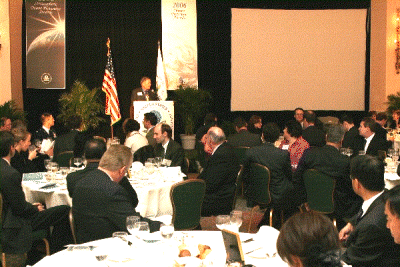
(Washington, D.C. - May 17, 2006) Food growers and producers, a pet food
company, and a personal care products company are among the 23 individuals,
organizations and companies from around the world that the U.S. Environmental
Protection Agency is recognizing for their efforts to protect the Earth's
climate and stratospheric ozone layer.
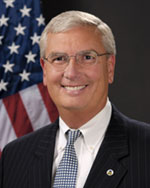
Stephen L. Johnson EPA Administrator
"By conserving resources and committing to renewable power, these leading
companies are proving that doing what is good for the environment can also be
good for business," said EPA Administrator Stephen L. Johnson. "Building on
President Bush's unparalleled commitment to reducing global greenhouse gas
emissions, EPA is working with our partners at home and abroad to reduce their
climate footprints in cost-effective ways."
Last year, the winners of the climate protection award and the stratospheric
protection award collectively purchased more than 1.5 million megawatt hours of
green power to avoid burning fossil fuels. They also generated wind and solar
power onsite, increased energy efficiency, recycled refrigerants, and slashed
the use of ozone-depleting substances and greenhouse gases.
EPA has honored 495 individuals and organizations from 40 countries since the
annual stratospheric ozone protection awards began in 1990. Subsequently, EPA
focused special attention on the reduction of greenhouse gases and protection of
the Earth's climate when it began the climate protection awards in 1998 and has
recognized 122 individuals and organizations from 16 countries since then.
2006 Climate Protection Award Winners:
Arizona Public Service Co., Phoenix, Ariz.
Baxter International Inc., Deerfield, Ill.
DENSO Corp., Kariya, Japan
IBM Corp., Armonk, N.Y.
Johnson & Johnson, New Brunswick, N.J.
The Department of Energy's National Renewable Energy Laboratory, Golden, Colo.
The United States Air Force
Yokota Tohoku Co., Tokyo, Japan
Mobile Air Conditioning Society Worldwide, Lansdale, Pa.
Refrigerant Reclaim Australia, Canberra, Australia
Barry G. Rabe, University of Michigan, Plymouth, Mich.
Mayor Gregory J. Nickels, Seattle, Wash.
Susan J. Brown, California Energy Commission, Sacramento, Calif.
2006 Stratospheric Ozone Protection Award Winners:
Kampffmeyer Mills, Hamburg, Germany
Nestlé Purina PetCare North America, St. Louis, Mo.
The Ozone Hole Website, Pocono Pines, Pa.
Australian Strawberry and Vegetable Growers, Australia
California Strawberry Commission, Watsonville, Calif.
The CFC Committee of the Federation of Pharmaceutical Manufacturers' Association
of Japan, Japan
COEXPHAL and ECOHAL, Spain
Environmental Investigation Agency, London, United Kingdom
John B. Mueller, Fumigation Service and Supply, Westfield, Ind.
The Ultraviolet Radiation Monitoring Team, United States
2006 EPA
Stratospheric Ozone Protection Awards
In 1990, EPA
established the Stratospheric Ozone Protection Awards to recognize exceptional
leadership, personal dedication, and technical achievements in protecting the
Earth’s stratospheric ozone layer. In the first sixteen years, The Stratospheric
Ozone Protection Award has been presented to 495 individuals, organizations and
teams from 40 countries. In 2005, eight individuals, organizations, associations
and teams earned the award through originality and public purpose, moral and
persuasive leadership, and elimination of emissions of ozone-depleting
substances.
Ten 2006 Stratospheric Ozone Protection
Awards were presented to winners on Wednesday, May 17, 2006 in Washington, D.C.
at an ceremony held at Mayflower Hotel.
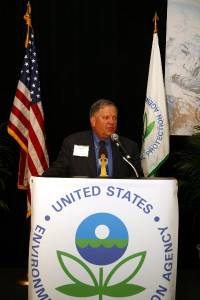
Dr. Stephen O. Andersen U.S. EPA Climate Protection Partnerships Division
started the evening with his opening remarks.
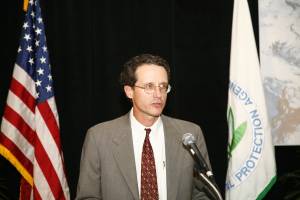
William Wehrum U.S. EPA, Office of Air and radiation gave the keynote address.
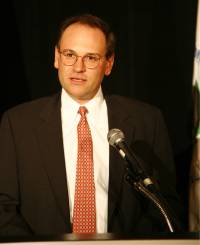
Wayne Balta VP Corporate Environmental Affairs and Product Safety IBM was the
next speaker.

Kathleen Hogan, Director U.S. EPA Climate Protection Partnerships Division
presented The 2006 Climate Protection Awards.
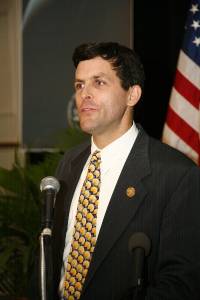
Ross Brennan, Chief,
Stratospheric Program Implementation Branch
U.S. EPA
Stratospheric Protection Division presented the Stratospheric Ozone
Protection Awards.
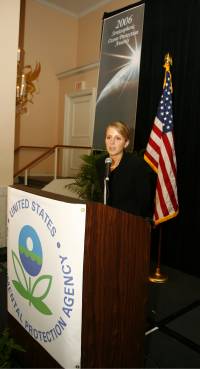
Kristen N. Taddonio, Strategic Projects Manager U.S. EPA Climate Protection
Partnerships Division gave the closing remarks of the ceremony.
CORPORATE AWARD
Kampffmeyer Mills
For Leadership in Phasing Out Methyl Bromide in the Food and Bakery Industry
Kampffmeyer Mills, the largest milling group in Europe, has halted their use of
methyl bromide at all their milling facilities in Germany and Hungary, where
they make one hundred different grain products and raw ingredients for the food
and bakery industry. Kampffmeyer is sharing its experience with the European
milling industry and has joined with other companies in funding milling
demonstrations of ozone-safe alternatives to improve knowledge and speed global
phaseout.

Nestlé Purina PetCare, North America
For Leadership in the Elimination of Methyl Bromide Use in Pet Food Processing
Nestlé Purina PetCare led the pet product
industry in phasing out the toxic and ozone-depleting chemical methyl bromide.
Thanks to the leadership of Kim Kemp and Larry Dean, methyl bromide is no longer
used in any of the company’s eight large pet food processing facilities in North
America. They accomplished this impressive phase-out through integrated pest
management, improved sanitation, and an innovative heat treatment program that
is being implemented by food processors throughout the world. Nestlé Purina
PetCare generously sponsors workshops to demonstrate this new ozone-safe process
technology, and has also trained thousands of pest management professionals and
quality control personnel at their Food Safety Symposiums.

The Ozone Hole, Inc.
For Leadership in Protecting the Ozone Layer through Education and Motivating
Change
The Ozone Hole is a nonprofit organization
dedicated to protecting the ozone layer, the climate and Earth’s environment by
educating and motivating the public through its internationally respected
website, http://www.theozonehole.com
. Leading Internet search engines rank The Ozone Hole website as the top
destination for information on ozone-related subjects. One particularly laudable
feature of The Ozone Hole website is their “Ask the Scientist Program” where
leading researchers and scientists answer questions submitted by students and
the general public about ozone depletion and atmospheric science.
ASSOCIATION & TEAM AWARDS
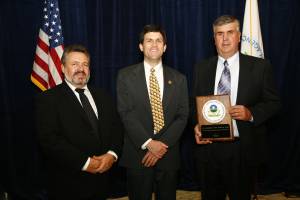
Australian Strawberry and
Vegetable Growers
For Leadership and Cooperation in Methyl Bromide Phase-Out in Australia
AUSVEG and Strawberries Australia, representing vegetable and strawberry
growers, led the phase-out of methyl bromide in Australia. Tomato, pepper, and
cucurbit growers halted methyl bromide use quickly, never needing critical use
exemptions. This was achieved by a strong industry-government partnership to
implement collaborative, targeted research and adopt alternatives. Farms in the
Bundaberg region, once Australia’s main user of methyl bromide, now produce 100%
of their vegetables using ozone-friendly alternatives. Growers in the Carnarvon
region eliminated methyl bromide in 2002. Australian strawberry fruit producers
only required a critical use exemption for one year (2005), but have now
eliminated methyl bromide use. Australian horticulturists achieved this success
through a nationwide network of growers, researchers, extension agents,
government and methyl bromide and alternative suppliers dedicated to
environmental protection.
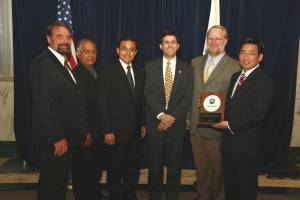
California Strawberry Commission
For Leadership and Cooperation in Reducing Methyl Bromide from U.S. Strawberry
Fields
The California Strawberry Commission is the world leader in developing
alternatives to methyl bromide and emission reductions. In 1999, methyl bromide
was used in 85% of the state’s strawberry acreage. By 2004, methyl bromide was
reduced to 55% of planted acres. The Commission has funded more than $10 million
to federal and state supported research projects, the largest contribution of
any agricultural group in the world. These research results have been shared
internationally with other agencies. The California strawberry industry is
environmentally responsible and committed to producing the world’s safest
nutritious fruit.
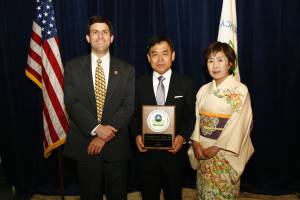
The CFC Committee of the Federation of Pharmaceutical Manufacturers’ Association
of Japan
For Leadership and Cooperation in CFC Elimination from Metered Dose Inhalers
The fourteen member companies of the CFC
Committee of the Federation of Pharmaceutical Manufacturers’ Association of
Japan (FPMAJ) are world leaders in the transition away from CFC-based
metered-dose inhalers (MDIs). They accomplished one of the world’s first
national CFC-MDI phaseouts. This was done through the combined efforts of
individual companies in cooperation with environmental authorities, using an
innovative transition strategy that maintained and in many cases improved care
for patients with chronic obstructive pulmonary disease and asthma. Today, there
are 21 brands of CFC-free alternatives – including HFC MDIs and dry powder
inhalers – on the market in Japan. The ozone layer has been protected without
adversely affecting the health of patients with respiratory diseases in Japan.
The Association of Harvesters
and Exporters of Fruit and Vegetables (COEXPHAL) and the Association of
Commercial Suppliers of Horticultural Products of Almería (ECOHAL)
For Leadership in the Phase-Out of Methyl Bromide in Europe
Sixty percent of Spain’s fresh vegetables are grown by members of the
Association of Harvesters and Exporters of Fruit and Vegetables (COEXPHAL), the
Association of Commercial Suppliers of Horticultural Products of Almería
(ECOHAL) and others in Almería. All of their vegetables—including tomatoes,
peppers, eggplants, melons and other cucurbits—are grown without the use of
methyl bromide. COEXPHAL AND ECOHAL worked with other organizations to develop
certified production standards for vegetables, promoting integrated pest
management and prohibiting the use of methyl bromided. COEXPHAL and ECOHAL
actively promoted the use of alternatives among growers. Today, methyl bromide
is completely phased out in this major horticultural region, and the producers
remain successful in local and international markets.
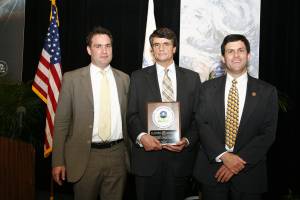
Environmental Investigation Agency
For Leadership and Collaboration in Preventing Smuggling of Ozone-Depleting
Chemicals
The Environmental Investigation Agency (EIA) is remarkably brave and successful
in exposing illegal trade and use of ozone depleting substances, in motivating
policy makers to take action, and in providing assistance to combat smuggling
operations. EIA carries out major undercover investigations into the black
market for CFCs and halons, exposing the methods and routes used by ODS
smugglers around the world, including the U.S. and Europe. EIA tells all, naming
companies and individuals in its reports. Close collaboration between EIA and
enforcement agencies has led directly to seizures, regional investigations,
focused enforcement activity, and more responsible practices by ODS exporters.
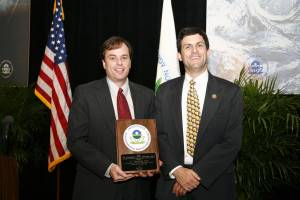
UV Monitoring Team
For Leadership and Teamwork in Collecting and Analyzing Ground-Level UV
Radiation Data
The UV Monitoring Team—Terry Keating (US
EPA), Patrick Disterhoft (NOAA/CIRES), and Michael Kimlin (formerly of the
University of Georgia)—ensured the continued collection and accurate analysis of
ground-level ultraviolet (UV) radiation. Since the mid-1990s, the U.S. EPA and
various partners have operated a nationwide network of Brewer
spectrophotometers, one of the largest networks of its type in the world.
Persevering through organizational and funding changes, this team has worked to
continue the operation of this unique scientific resource, allowing scientists
and policymakers to track the damage from ozone depletion and watch for
recovery.
Team Members:
- Patrick Disterhoft, U.S. National
Oceanic and Atmospheric Administration, Cooperative Institute for Research in
Environmental Sciences
- Terry Keating, U.S. Environmental
Protection Agency
- Dr. Michael Kimlin, Institute of Health
and Biomedical Innovation, Queensland University of Technology (formerly
University of Georgia)
INDIVIDUAL AWARD
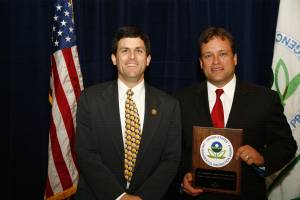
John B. Mueller
For Leadership and Innovation in Implementing Methyl Bromide Alternatives
John Mueller, president of Fumigation
Service and Supply, has shown leadership, dedication and achievement in
developing and commercializing methyl bromide alternatives. His activities led
to the phase-out of methyl bromide in many mills, food processing structures and
stored product fumigations in North America. Under John Mueller’s leadership,
Fumigation Service and Supply performed the first U.S. commercial fumigations
with sulfuryl fluoride and the combination of phosphine, carbon dioxide and
heat. They continue to implement a full range of alternatives using integrated
pest management (IPM). Their innovative fumigation techniques and IPM allow
their customers to fumigate less often and avoid using methyl bromide
altogether. John Mueller shares his valuable expertise by training fumigators
and pest control operators in North America and in other regions of the world.
Previous years
winners click here
2006 Climate Protection Award Winners
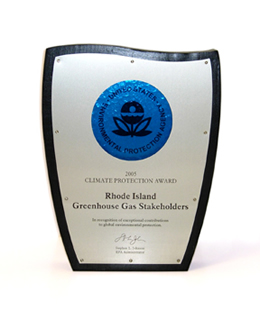
CORPORATE, GOVERNMENT & MILITARY AWARDS
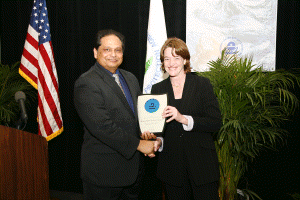
Arizona Public Service Company
In 1994, the Arizona Public Service Company (APS) joined the Department of
Energy's Climate Challenge Program and committed to reduce system-wide GHG
emissions in absolute tons to below the 1990 level by the target year 2000. APS
achieved this ambitious goal, even as total generation grew 21% (from 19.9 to
24.1 million megawatt hours). By the year 2010, APS will reduce carbon intensity
by 10% below 2000 level by implementing demand-side management, expanding its
renewable energy portfolio, reusing coal combustion by-products, increasing
power plant energy efficiency, managing generation fuel-mix, and reducing
emissions of sulfur hexafluoride (SF6) used in electric switch gear.
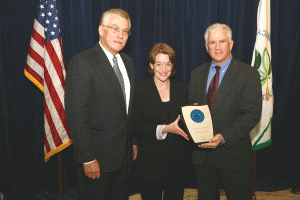
Baxter International Inc.
Baxter International was a charter member of the EPA Climate Leaders program and
a founding member of the Chicago Climate Exchange. The firm has partnered with
EPA's Performance Track and Energy Star programs to promote responsible actions
to protect the environment. Through these voluntary commitments and internal
programs, Baxter reduced total greenhouse gas emissions by 35% per unit of
production value from 1996-2004. Baxter continues to invest in capital
improvements and manufacturing technologies to further reduce its global warming
impacts and is currently setting a new greenhouse gas emissions reduction goal
for 2010.
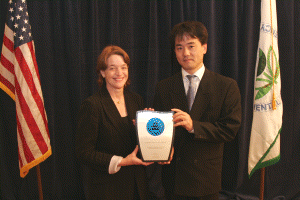
DENSO Corporation
Refrigeration and air conditioning technologies have a large impact on the
earth's climate, first because of the power they consume, and secondly, through
the refrigerants they use. There are large opportunities to protect the Climate
by improving these technologies. DENSO has done this by reducing the energy use
and refrigerant emissions of residential heat pumps, vehicle air conditioning
and refrigerant units. One extraordinary technology DENSO developed is the
Ejector Cycle. When this technology is installed in a refrigeration unit,
combined with other complementary breakthroughs in components and controls, it
demonstrates efficiency improvements of 50 percent or more and leads to a 70%
reduction in refrigerant greenhouse gas emissions. If implemented in every
Japanese household and vehicle, DENSO estimates that country-wide emissions
would fall by 13,180,000 tons per year. DENSO is also a founding member of the
Mobile Air Conditioning Climate Protection Partnership. This partnership pledged
to reduce vehicle refrigerant emissions by at least 50% and to improve air
conditioning fuel efficiency by at least 30%.
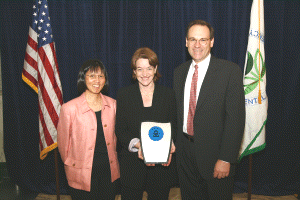
IBM Corporation
Since earning its first EPA Climate Protection Award in 1998, IBM has redoubled
its pioneering climate protection campaign and achieved extraordinary results.
In 1998, IBM became the first semiconductor manufacturer in the world to
announce a company specific perfluorocompound (PFC) emission reduction goal.
Upon joining EPA Climate Leaders in 2002, IBM continued to aggressively invest
in energy conservation projects; increased the purchase of renewable energy on a
worldwide basis; developed and implemented process conversions to reduce
high-global warming impact PFC emissions from its semiconductor manufacturing;
and significantly increased employee participation in car pools and working from
home. Between 2000 and 2005, IBM achieved an annual average CO2 emission
reduction of 6.2% by implementing energy conservation projects and purchasing
renewable energy, and reduced its PFC emissions by a total of 61.9%. In 2005,
IBM avoided 485 thousand metric tons of CO2 emissions, which is equivalent to
not burning nearly 1.1 million barrels of oil.
IBM is the first corporation to earn two
EPA Climate Protection Awards.
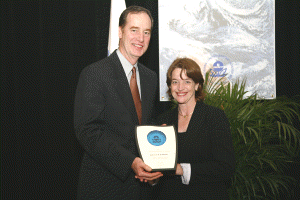
Johnson & Johnson
In 2005, Johnson & Johnson purchased more green power than any other corporation
in the United States. This outstanding support of renewable energy has earned it
the EPA Green Power Leadership Award for the past four years. Each Johnson &
Johnson facility chooses how to capitalize on local renewable energy
opportunities, with projects ranging from a landfill gas combined heat and power
project in California to photovoltaic solar energy cells in New Jersey. The
company now purchases over 304,000 Megawatt hours of renewable energy annually
in the US and generates a significant amount of its own green power through
on-site solar and landfill gas projects. Johnson & Johnson has committed to
reducing its carbon dioxide emissions to 7 percent below 1990 levels by 2010, in
absolute terms, and believes green power will play a major role in achieving
that target. As of the end of 2005, the company's carbon dioxide emissions
worldwide were 11.5% below 1990 levels.
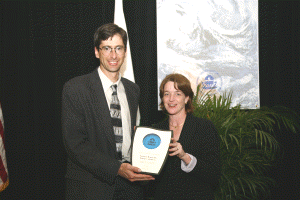
The National Renewable Energy
Laboratory
The Department of Energy's National Renewable Energy Laboratory (NREL) is a
world leader in renewable energy technology, including development and testing
of sustainable energy technology. Their research and engineering activities are
the basis of numerous important advances in photovoltaics, wind energy, building
technology, advanced vehicle and automotive systems, solar thermal electric,
hydrogen, superconductivity, geothermal power, and distributed energy. NREL is a
founding member of the U.S. EPA Green Power Partnership and the Mobile Air
Conditioning Climate Protection Partnership. NREL was also the first federal
participant in the EPA Climate Leaders Partnership (CLP). NREL was one of five
CLP members to set and successfully meet a greenhouse gas emissions reduction
goal (10 percent per square foot from 2000 to 2005). Additionally, NREL's
analytical contribution to the EPA Mobile Air Conditioning Climate Protection
Partnership will allow the automotive community to prevent over 35 billion
kilograms of carbon dioxide equivalent emissions annually and save the average
consumer hundreds of dollars over the life of their vehicle.
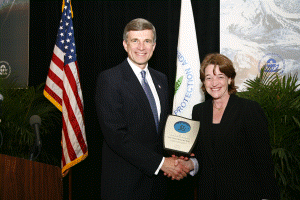
The United States Air Force
The U.S. Air Force has demonstrated outstanding commitment to the use of
renewable energy by becoming America's largest green power customer and by
investing in significant on-site biomass, wind farm, and photovoltaic
generation. In 2004, the Air Force's purchase of 321 thousand megawatt hours of
green power earned them the top ranking in the U.S. EPA Green Power Partnership
and the Green Power Partner of the Year Award. In 2005, the Air Force expanded
on-site renewable energy projects and increased green power purchases by over
300%, making them one of the first organizations in the world to purchase over
one million megawatt hours of green power. These impressive efforts currently
reduce CO2 emissions by 1.38 billion pounds annually-equivalent to saving 1.5
million barrels of oil or taking 135,000 cars off the road.
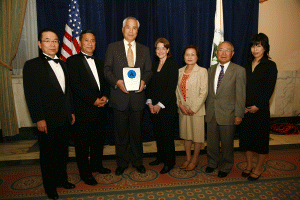
Yokota Tohoku, Inc.
Yokota Tohoku company is committed to developing products that protect the
environment. In 1995, Yokota Tohoku designed a new process to manufacture food
containers that are recycled with far less energy use and greenhouse gas
emissions. The "re-re-pack" process also reduces environmental pollutants,
creates less solid waste, and reduces the use of water, water heating, and
detergents. Yokota Tohoku goes even further beyond the call of duty with public
education programs that encourage customers to avoid waste by reusing and
recycling, and has created a visitor center dedicated to environmental
protection. Yokota's combined efforts save energy, reduce environmental impacts,
and promote higher environmental literacy among children and customers.
ORGANIZATION & ASSOCIATION AWARDS
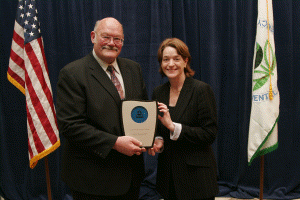
Mobile Air Conditioning Society
Worldwide
The Mobile Air Conditioning Society (MACS) is the global leader in improving the
environmental performance of vehicle air conditioning service. When CFC
refrigerant emissions from automotive air conditioning were discovered to cause
severe damage to the Ozone Layer, MACS was the first to promote refrigerant
containment, recovery and recycling to automotive technicians through their
training programs, conventions, publications, website, and networking
activities. As a result of their actions, which have been copied worldwide,
millions of pounds of ozone-depleting CFC refrigerant were kept from being
vented to the atmosphere. Now, MACS is an integral member of the Mobile Air
Conditioning Climate Protection Partnership that is working to reduce HFC
greenhouse gas refrigerant emissions by at least 50% and to improve air
conditioner efficiency by at least 30%. Thanks to MACS, the vehicle air
conditioning industry is at the forefront of environmental responsibility.
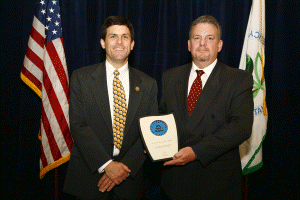
Refrigerant Reclaim Australia
Since its founding more than a decade ago, Refrigerant Reclaim Australia (RRA)
has collected and destroyed more than 1350 metric tons of mixed fluorocarbon
refrigerant, reducing greenhouse gas emissions by the equivalent of
approximately seven million tons of CO2. RRA is a not-for-profit,
industry-funded company that is responsible for the recovery and safe
destruction of refrigerants in Australia. In the original business plan,
importers of fluorocarbon refrigerants voluntarily contributed A$1 per kilogram
of refrigerant imported to pay the costs of refrigerant management, including a
bounty for refrigerants returned to a national facility for safe destruction in
a plasma-arc furnace. More recently, the Commonwealth legislature introduced
product stewardship as a requirement for importers of refrigerant, including
that contained in equipment, to formalize the program. The current bounty paid
for return of contaminated refrigerants is A$5 per kilogram. They also take back
material for destruction from other countries, including material from New
Zealand and Indonesia.
INDIVIDUAL AWARDS
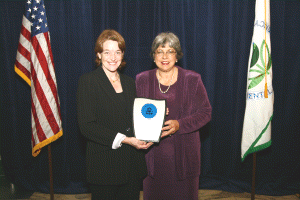
Susan J. Brown
Susan Brown's commitment to climate protection has inspired professional and
elected officials to take action at state and local levels throughout
California. She represents the State of California on the tri-state West Coast
Governor's Global Warming Initiative, coordinates California's stakeholder input
process for climate action planning, leads the state's energy team in
strategizing to reduce greenhouse gas emissions, and advocates for local
government participation in the state's response to global warming. Susan Brown
was particularly influential in crafting the West Coast Governor's Global
Warming Initiative-the leading state action on climate change in the United
States.

Gregory J. Nickels
Seattle Mayor Gregory Nickels demonstrated extraordinary leadership and personal
dedication by creating the U.S. Mayors Climate Protection Agreement, under which
over 200 mayors representing more than 44 million Americans in 39 states have
committed to climate protection. Under this agreement, cities agree to take
three actions: 1. Meet or beat the Kyoto Protocol targets; 2. Urge state and
federal governments to meet or beat Kyoto Protocol greenhouse gas emission
reduction targets; and 3. Urge the U.S. Congress to pass bipartisan greenhouse
gas reduction legislation and establish a national emission trading system. In
June 2005, the U.S. Conference of Mayors strengthened cities' resolve by
unanimously endorsing the U.S. Mayors Climate Protection Agreement. Mayor
Nickels has succeeded in raising public awareness locally and nationally and has
demonstrated the role of local governments on this critical environmental and
economic issue. His leadership has energized climate protection work in many
communities throughout the USA.
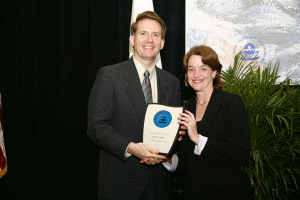
Barry G. Rabe
Professor Barry G. Rabe (Gerald R. Ford School of Public Policy, University of
Michigan) was the first to document and analyze how and why U.S. states are
taking the lead on climate protection. His research, publications, speeches and
one-on-one interactions guide and inspire states to select successful climate
protection strategies that build prosperity while protecting the environment for
future generations. Professor Rabe has documented how states from all regions of
the United States have pursued cost-effective strategies that lower their
climate impact. As a result of his work, politicians and the public know how
states can combat climate change. Dr. Rabe also holds appointments in the
University's Program in the Environment and School of Natural Resources and
Environment. He continues to pursue research on the evolution of renewable
portfolio standards; strategies to build collaboration across state boundaries;
policy differences between U.S. states and Canadian provinces, and prospects for
further U.S.- Canadian collaboration on climate change.
|
































